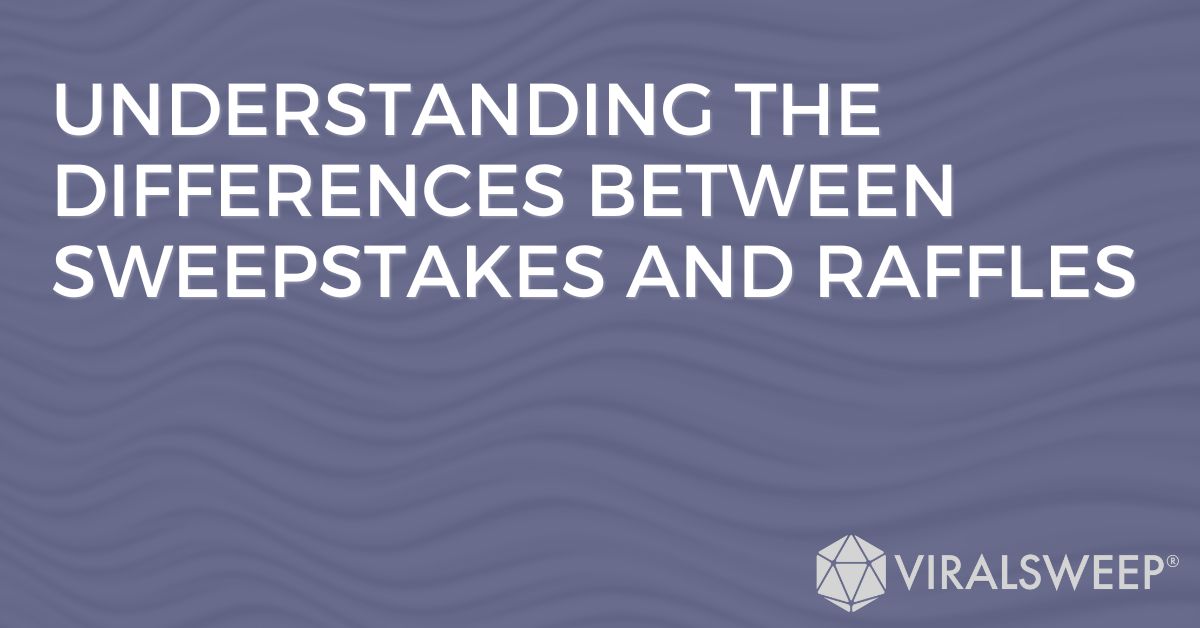Everyone loves a raffle—right?
Actually, raffles are frequently confused with sweepstakes. Raffles and sweepstakes both choose winners at random. But, raffles require a purchase to enter. This makes raffles, legally, a form of gambling. Gambling laws vary from state to state; and in many states, online raffles are illegal.
Understanding the differences between these giveaways can protect your business from fines and penalties. A sweepstake is one of the most effective ways to promote your company on social media, improve your online fundraising, and create a “viral” moment that helps your company get more visibility.
But, how you set up this giveaway makes all the difference. Mistakenly running a raffle when you wanted to host a sweepstakes can lead to negative backlash. So, let’s explore the differences between sweepstakes and raffles to make sure your promotion is set up for success.
What Are Sweepstakes?
Sweepstakes are promotions in which winners are chosen at random from all eligible entrants. There is no purchase necessary to enter a sweepstakes, and entrants must not be required to pay any consideration (money or other valuables) in order to enter. For example, a sweepstakes may ask participants to submit their email addresses to win a $100 gift card.
The most defining part of sweepstakes is that a winner is chosen by luck and not by skill. Sweepstakes are what some consider a “game of chance.”
The term “sweepstakes” is thought to have originated in the late 14th century to mean “someone who ‘sweeps’, or takes the whole of, stakes in a game,” according to Oxford Reference. The first charity sweepstakes were started by New Hampshire in 1964 as a way to provide funds for the public school system without initiating sales or income taxes in the state. Brands like Coca-Cola and Procter & Gamble popularized sweepstakes, but until the recent advent of online sweepstakes, this type of promotion had become less trendy.
Today, sweepstakes are back in vogue on social media and online. Consumers love sweepstakes; one study estimated that contests, including sweepstakes campaigns, have a conversion rate of almost 35%. And, tools like ViralSweep make it easy for brands to promote and run a sweepstakes.
Types of Sweepstakes
Sweepstakes can take many different forms. A sweepstakes fundraiser for a local business, for instance, will be different from a nationwide mail-in campaign. Here are some of the most common and popular ways to host a sweepstakes giveaway.
- No-purchase-necessary sweepstakes: This is the most common type of sweepstakes in which there is no purchase necessary to participate, and entrants must not be required to pay any consideration (money or other valuables) to enter.
- Mail-in sweepstakes: Entrants are required to mail in a postcard or entry form to enter.
- Online sweepstakes: People can enter online, usually by providing their name, email address, and other contact information.
- SMS sweepstakes: Participants enter by texting a keyword to a designated number.
- Social media sweepstakes: Social media users enter by liking, sharing, or commenting on a social media post.
- Multi-level sweepstakes: Entrants can earn additional entries by referring friends or completing other tasks.
The type of sweepstakes you choose will depend on your marketing goals and budget. If you are looking to reach a large audience, an online sweepstakes or social media sweepstakes may be a good option. If you are looking to generate leads, a mail-in sweepstakes or text message sweepstakes may be the better choice.
[Read more: Grow Your Business With Sweepstakes Marketing]
How Sweepstakes Work
Depending on the type of sweepstakes you choose, the first step is to create entry requirements. Most sweepstakes require entrants to provide their name, email address, and other contact information. Some sweepstakes, such as a multi-level sweepstakes, may also require entrants to answer a question or complete a task.
The process for selecting winners will also vary depending on the specific sweepstakes. Some companies use tools like ViralSweep to pick winners randomly. Other companies use Excel to create a randomized list of entries and choose a random sweepstakes winner.
Sweepstakes are promoted in a variety of ways, such as via print, television, or radio advertising. Today, most successful sweepstakes are promoted through social media, influencer campaigns, email, or word-of-mouth marketing.
The sweepstakes winners are alerted by email, phone, social media, or mail. Some sweepstakes may also require winners to claim their prizes in person.
[Read more: The Advanced Guide To Sweepstakes from ViralSweep]
Pros and Cons of Sweepstakes
Sweepstakes can be a great way to boost your brand awareness, generate leads, and engage with customers.
Sweepstake giveaways get your brand and your product in front of a wider audience. Depending on the way you set up your sweepstakes, you can encourage people to spread the word about your company in order to win. And, when someone enters your sweepstakes giveaway, they’re more likely to remember your brand and consider your products or services in the future.
For your sales funnel, a sweepstake can be a great way to generate leads. Sweepstakes often require participants to provide their contact information to enter. This information can be used to market your products or services, build your email list, and reach out to them in the future.
And, sweepstakes provide an opportunity to engage with your audience and solicit user-generated content. Customers get a chance to win something valuable; this helps to build relationships and create a sense of excitement around your brand.
However, there are also some drawbacks to sweepstakes. These promotions can be expensive to run, once you factor in the cost of prizes, marketing, and administration.
It’s also important to note that sweepstakes are regulated by the Federal Trade Commission (FTC). You need to make sure that your sweepstakes complies with all applicable laws.
However, sweepstakes rules are nothing in comparison to the rules around running a raffle.
What is a Raffle?
A raffle is a promotion in which winners are chosen at random from among those who have paid a fee to enter.
Raffles have roots in ancient Egypt, where raffle-esque games were used for community entertainment and fundraising. Today, raffles are considered a form of gambling, and they are therefore subject to more stringent regulations than sweepstakes.
Not all states allow raffles. Raffles of any kind are 100% against the law in Alabama, Hawaii, and Utah. Those states that do allow this type of giveaway often have restrictions on the amount of money that can be charged per entry, the type of prizes that can be offered, and the location where the raffle can be conducted.
[Read more: Step-by-Step Guide to Running a Raffle on Shopify]
Most raffles are used as an effective fundraising tool for charities and nonprofits. Charity raffles are regulated by the IRS under Notice 1340:
“Generally, an exempt organization must report raffle prizes if (a) the amount paid reduced, at the exempt organization’s option, by the wager (the amount a person paid for the chance to win a prize), is $600 or more; and (b) the payout is at least 300 times the amount of the wager.”
Types of Raffles
The unifying feature of all raffles is that, like sweepstakes, raffles are games of chance. Whether you’re running an online raffle or a charity raffle, you must find a way to choose the raffle winner at random.
Here are a few different types of raffles you may choose to host in places that allow your business to do so.
- Standard raffle: Tickets are sold, and the winner is chosen at random.
- 50/50 raffle: Half of the amount raised via raffle ticket sales goes to the nonprofit, and the other half goes to the raffle winner.
- Online raffle: Winners can compete for prizes virtually, with the winner announced online live or in a social media post, for example.
- Instant win raffle: Participants to win prizes immediately after entering. This type of raffle works at events where names or tickets are pulled out of a jar and the prize is instantly awarded.
- Reverse raffle: Instead of the winner being the first ticket drawn, winners are the ones left standing when all the tickets have been drawn.
Te best type of raffle for a particular fundraising campaign will depend on the goals of the organization running the campaign and the budget available.
For example, if an organization is looking to raise a large amount of money, a standard fundraising raffle may be the best option. However, if an organization is looking to get people involved in their organization or event, a 50/50 raffle or an instant win raffle may be a better option.
How Raffles Work
Raffles are very similar to sweepstakes — with one key difference. Most raffles require entrants to purchase a ticket to enter.
From there, entrants will need to provide certain personal information (name and contact information) along with their payment. The process for drawing the winner of a raffle will vary depending on the specific raffle. Most raffles draw the winner at random.
Like sweepstakes, raffles are promoted through social media, email marketing, event marketing, and traditional advertising. The winners are usually informed in person (especially in the case of instant raffles) or via email or phone.
Pros and Cons of Raffles
Raffles, like sweepstakes, can help increase visibility for nonprofit organizations and eligible businesses. Increased awareness can be helpful for organizations that are trying to raise awareness of their cause or attract new supporters.
Raffles also help engage the community by giving people a chance to come together and support a common cause. This can be a great way to build momentum with community members as you look to improve fundraising.
Ultimately, raffles have the potential to raise significant funds for an organization. Even the most simple raffles can attract a large number of participants, each of whom is typically willing to pay a small amount of money to enter.
However, raffles are regulated by law in many jurisdictions. Organizations that run raffles need to be aware of the legal requirements in their jurisdiction and comply with those requirements.
Like sweepstakes, raffles can be expensive to run. And, there is always the risk of fraud with raffles. Some people may try to scam entrants by collecting their personal information or by promising prizes that they never intend to deliver.
Sweepstakes vs Raffles: Primary Differences
Sweepstakes and raffles are both types of promotions that offer prizes to participants, but they have different legal requirements and implications. It is important to understand the differences between these two giveaways to avoid the risk of running an illegal lottery and protect your brand reputation.
Legal Considerations
The regulations that govern sweepstakes and raffles vary from state to state. However, there are some general laws and regulations that apply to all sweepstakes and raffles.
The FTC regulates sweepstakes and raffles on a federal level. The FTC prohibits deceptive or misleading advertising, including advertising that makes false or dubious claims about the odds of winning a sweepstakes or raffle.
In addition to federal law, raffles are also regulated by state law. Currently, raffles are legal with various restrictions in 47 of the 50 states, with the exception of Alabama, Hawaii, and Utah. Understanding the difference between raffles and sweepstakes will help you stay compliant with these regulations.
The specific laws that apply to sweepstakes and raffles vary from state to state. However, some common requirements include:
- Providing clear and conspicuous disclosures: The terms of the sweepstakes or raffle must be clear and easy to find. This includes disclosing the odds of winning, the method of selecting winners, and any restrictions on eligibility.
- Provide AMOE: For sweepstakes, Alternative Method of Entry (AMOE) Laws apply to sweepstakes to ensure they are fair and accessible to everyone, regardless of their ability to purchase a product or service.
- Providing a way to contact the sponsor: The organizer of the sweepstakes or raffle must provide a way for participants to contact the them with questions or concerns.
- Providing a way to report winnings: The sweepstakes or raffle organizer must provide a way for winners to report their winning ticket and claim their prizes.
[Read more: No Purchase Necessary: Laws and Best Practices]
The consequences of not meeting these raffle laws varies depending on the state and the level of the offence. The FTC will impose fines on organizations that run afoul of their laws.
“The Federal Trade Commission (FTC) can assess fines for each violation between $5,000 and $50,000. The Federal Communications Commission can fine companies up to $4,000 per violation. Some sweepstakes also fall under the jurisdiction of the United States Postal Service and those fines are as high as $2 million,” wrote one legal expert.
Businesses also risk legal action by participants in the giveaway and damage to their brand reputation.
Entry Process
The process of entering a sweepstakes or raffle varies depending on the specific promotion. The official rules will outline the eligibility requirements, the entry methods, the odds of winning, and the prize(s).
The rules will also detail the entry methods. For sweepstakes and raflfes, there are three main entry methods: online entry, mail-in entry, and purchase-based entry. Online entry is the most common and convenient way for participants to enter. Mail-in entry is less convenient, but it can give entrants a better chance of winning. Purchase-based entry is the least convenient way to enter, but it can be the easiest way to enter.
Note that in the case of raffles, a purchase will have to be made along with the desired method of entry.
Once you have chosen an entry method, you will need to collect participant information, randomly select a winner, and notify them of their prize in a timely manner.
Winner Selection
The process of selecting winners for sweepstakes and raffles varies depending on the specific promotion. However, there are some general criteria that are commonly used.
Random drawing is the most common method of selecting winners for sweepstakes. All entries are placed in a pool, and then one or more winners are randomly selected. This method is considered to be fair and impartial
Skill-based contests are a type of sweepstakes that require entrants to demonstrate a certain skill or knowledge in order to win. The sweepstakes could involve answering trivia questions, completing a puzzle, or sharing a piece of user-generated content. Skill-based contests are often seen as being more engaging than random drawings, and they can help to attract a more skilled and motivated pool of entrants.
Lucky numbers are a type of raffle where winners are selected based on a predetermined set of numbers. This could involve choosing numbers from a hat, drawing numbers from a lottery machine, or using a random number generator. Lucky number raffles are often seen as being more exciting than random drawings, and they can help to create a sense of anticipation among entrants.
Note that sweepstakes typically offer prizes that are not related to skill or chance, such as cash, cars, or vacations. Raffles typically offer prizes that are related to chance, such as gift cards or merchandise.
And, sweepstakes are often won by one person, while raffles can have multiple winners.
Purpose
Raffles and sweepstakes can serve a number of key business purposes.
Most companies use sweepstakes and raffles to promote a product, service, or event. These giveaways generate excitement and buzz and can also help to attract new customers.
For nonprofit organizations, sweepstakes and raffles offer a way to raise money for a good cause. They can help to bring people together and create a sense of excitement and anticipation.
A successful giveaway need a strong, relevant theme. No matter what format you use, you’ll also need a way to target the right audience with appealing prizes. You need to promote your sweepstakes or raffle widely in order to get people to enter. This means using a variety of channels, such as social media, email, and print advertising.
And finally, it is important to run your sweepstakes or raffle fairly. Follow all of the rules and regulations to ensure that everyone has an equal chance of winning.
Sweepstakes or Raffles — We Can Help
ViralSweep is your partner in running online contests that are well organized, compliant, and set up to increase your engagement. ViralSweep’s Sweepstakes App enables you to grow your email & SMS list, increase engagement, and generate sales with Sweepstakes.
Plus, explore our many resources and tools to help make your next campaign successful. From ways to grow your email list to templates for no purchase necessary rules, you’ll find everything you need on our platform.
Get in touch to see how we can take your sweepstakes marketing to the next level.





















